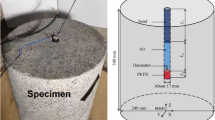Abstract
Rock fragmentation by blasting is the most efficient way of rock breakage in hard rock mining applications. Fragmentation, as well as the properties of the fragments generated by the explosion, are of significant concern as the energy consumption at the mill is greatly affected by them. Dynamic loading of blasting generates a countless number of microcracks in the host rock, which despite the major cracks forming the fragments could not get enough time to coalesce and create macrocracks. These microstructures eventually impact the integrity of the intact rock and reduce its strength. Damage is considered as a scalar parameter, which accounts for the creation of flaws and microstructures in the rock, deteriorating its elasticity modulus. The stress waves and their interactions are the parameters that control damage around blastholes. In this study, using LS-DYNA numerical code, the effect of initiation timing on blast-induced rock damage and fragmentation is investigated. The results of the numerical models reveal the importance of the delays in damage as well as fragment size distribution. Delayed initiation provides enough timing for the cracks to grow, which preconditions the surrounding rock for the neighboring blasthole. The interaction between the stress waves resulting from the detonation of neighboring blastholes plays an important role in damage and fragmentation analysis. The optimum delay time can be obtained by considering the rise time and the duration of the stress pulse, the P and S wave travel times in the host rock, and the crack propagation time within the rock burden.

























Similar content being viewed by others
References
Blair DP (2009) Limitation of electronic delays for the control of blast vibration and fragmentation. In: 9th international symposium on rock fragmentation by blasting. Taylor & Francis Group, Granada, Spain, pp 171–184. https://doi.org/10.1055/s-2008-1040325
Borrvall T, Riedel W (2011) The RHT concrete model in LS-DYNA. In: 8th European LS-DYNA users conference, Strasbourg, Austria
Brinkmann JR (1990) An experimental study of the effect of shock and gas penetration in blasting. In: 3rd international symposium on rock fragmentation by blasting. Brisbane, Australia, pp 55–66
Chi LY, Zhang ZX, Zong X, Aalber A, Yang J, Li C (2019) Fracture processes in granite blocks under blast loading. Rock Mech Rock Eng 52(3):853–868. https://doi.org/10.1007/s00603-018-1620-0. (Springer Vienna)
Dobartz BM, Crawford PC (1985) LLNL explosives handbook. Lawrence Livermore National Laboratory, Livermore
Fried LE (1994) Cheetah 1.0 users manual (no. UCRL-MA-117541). Lawrence Livermore National Lab, Livermore, CA. USA. https://doi.org/10.2172/10165726
Hallquist JO (2018) LS-DYNA theory manual. Livermore Software Technology Corporation, Livermore, CA, USA
Hashemi AS, Katsabanis P (2018) Estimation of tensile strength of Laurentian granite under high strain rate loading. In: 12th international symposium on rock fragmentation by blasting. Lulea, Sweden, pp 93–102
Johansson D, Ouchterlony F (2013) Shock wave interactions in rock blasting: the use of short delays to improve fragmentation in model-scale. Rock Mech Rock Eng 46(1):1–18. https://doi.org/10.1007/s00603-012-0249-7
Katsabanis PD, Gkikizas N (2016) Effect of delay time on stress induced damage and fragmentation. Blast Fragm 10(2):89–103
Katsabanis PD, Tawadrous A, Braun C, Kenedy C (2006) Timing effects on the fragmentation of small scale blocks of granodiorite. Fragblast 10(1–2):83–93. https://doi.org/10.1080/13855140600858339
Katsabanis PD, Omidi O, Rielo O, Ross P (2014) Examination of timing requirements for optimization of fragmentation using small scale grout samples. Blast Fragm 8(1):35–53. https://doi.org/10.1055/s-2008-1040325
Kim SJ (2010) An experimental investigation of the effect of blasting on the impact breakage of rocks. Master’s Thesis, The Robert M. Buchan Department of Mining, Queen’s University, Kingston, Ontario, Canada
Ledoux L (2015) The role of stress waves and gases in the development of fragmentation. Mater’s Thesis, The Robert M. Buchan Department of Mining, Queen’s University, Kingston, Ontario, Canada
Marsh SP (1980) LASL shock hugoniout data. University of California Press, Berkeley, USA
Ouchterlony F (2005) The Swebrec© function: linking fragmentation by blasting and crushing. Min Technol 114(1):29–44. https://doi.org/10.1179/037178405x44539
Ouchterlony F (2009) Fragmentation characterization: the Swebrec function and its use in blast engineering. In: 9th international symposium on rock fragmentation by blasting. CRC Press, Granada
Persson P, Holmberg R, Lee J (1993) Rock Blasting and Explosives Engineering. CRC Press, Boca Raton, FL, USA
Riedel W, Thoma K, Hiermaier S, Schmolinske E (1999) Penetration of reinforced concrete by BETA-B-500, numerical analysis using a new macroscopic concrete model for hydrocodes. In: 9th international symposiumon interaction of the effects of munitions with structures. Berlin, Germany, pp 315–322
Rossmanith HP (1983) Rock fracture mechanics. Springer Wien, NewYork
Rossmanith HP (2002) The use of lagrange diagrams in precise initiation blasting. Part I: two interacting blastholes. Fragblast 6(1):104–136. https://doi.org/10.1076/frag.6.1.104.8854
Sanchidrián JA, Ouchterlony F, Moser P, Segarra P, Lopez L (2012) Performance of some distributions to describe rock fragmentation data. Int J Rock Mech Min Sci 53:18–31. https://doi.org/10.1016/j.ijrmms.2012.04.001
Schill M, Sjöberg J (2012) Finite element simulations of blasting and fragmentation with precise initiation. In: 12th international LS-DYNA users conference, Detroit, MI, USA
Stagg MS, Rholl SD (1987) Effects of accurate delays on fragmentation. In: 2nd international conference on rock fragmentation by blasting. Keystone, Colorado, pp 210–223. https://doi.org/10.1055/s-2008-1040325
Vanbrant F, Espinosa A (2006) Impact of short delays sequence on fragmentation by means of electronic detonators: theoretical concepts and field validation. In: 8th international symposia on rock fragmentation by blasting, pp 326–331. https://doi.org/10.1055/s-2008-1040325
Yi C, Johansson D, Nyberg U, Beyoglu A (2016) Stress wave interaction between two adjacent blast holes. Rock Mech Rock Eng 49(5):1803–1812. https://doi.org/10.1007/s00603-015-0876-x. (Springer Vienna)
Yi C, Sjöber J, Johansson D, Petropoulos N (2017) A numerical study of the impact of short delays on rock fragmentation. Int J Rock Mech Min Sci 100(March):250–254. https://doi.org/10.1016/j.ijrmms.2017.10.026. (Elsevier Ltd)
Author information
Authors and Affiliations
Corresponding author
Ethics declarations
Conflict of interest
The authors declare that they have no conflict of interest.
Additional information
Publisher's Note
Springer Nature remains neutral with regard to jurisdictional claims in published maps and institutional affiliations.
Rights and permissions
About this article
Cite this article
Saadatmand Hashemi, A., Katsabanis, P. The Effect of Stress Wave Interaction and Delay Timing on Blast-Induced Rock Damage and Fragmentation. Rock Mech Rock Eng 53, 2327–2346 (2020). https://doi.org/10.1007/s00603-019-02043-9
Received:
Accepted:
Published:
Issue Date:
DOI: https://doi.org/10.1007/s00603-019-02043-9




